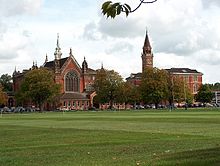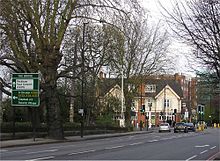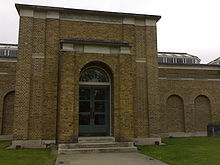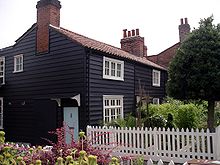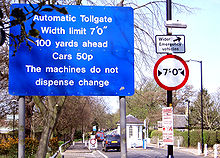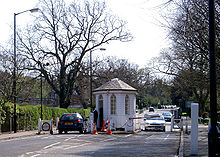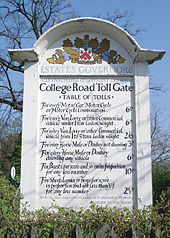- Dulwich
-
- This article is about Dulwich in London. Dulwich, South Australia is a suburb of Adelaide.
Coordinates: 51°26′45″N 0°04′40″W / 51.4457°N 0.0779°W
Dulwich 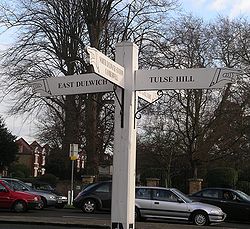
Dulwich village signpost
 Dulwich shown within Greater London
Dulwich shown within Greater LondonPopulation approximately 30000 OS grid reference TQ345725 London borough Southwark Ceremonial county Greater London Region London Country England Sovereign state United Kingdom Post town LONDON Postcode district SE21, SE22 Dialling code 020 Police Metropolitan Fire London Ambulance London EU Parliament London UK Parliament Dulwich and West Norwood London Assembly Lambeth and Southwark List of places: UK • England • London Dulwich (
 /ˈdʌlɨtʃ/) is an area of South London, England. The settlement is mostly in the London Borough of Southwark with parts in the London Borough of Lambeth. Dulwich, consisting of East Dulwich, West Dulwich and Dulwich Village lies in a valley between the neighbouring districts of Camberwell, Crystal Palace, Denmark Hill, Forest Hill, Gipsy Hill, Knights Hill, Herne Hill, Honor Oak, Peckham, Penge, Sydenham Hill, Tulse Hill and West Norwood. Dulwich was in Surrey until 1889, when the County of London was created. The modern western boundary with the neighbouring Borough of Lambeth, Croxted Road, derives its name from a very old pilgrim way, Croke (i.e. crooked) Street.
/ˈdʌlɨtʃ/) is an area of South London, England. The settlement is mostly in the London Borough of Southwark with parts in the London Borough of Lambeth. Dulwich, consisting of East Dulwich, West Dulwich and Dulwich Village lies in a valley between the neighbouring districts of Camberwell, Crystal Palace, Denmark Hill, Forest Hill, Gipsy Hill, Knights Hill, Herne Hill, Honor Oak, Peckham, Penge, Sydenham Hill, Tulse Hill and West Norwood. Dulwich was in Surrey until 1889, when the County of London was created. The modern western boundary with the neighbouring Borough of Lambeth, Croxted Road, derives its name from a very old pilgrim way, Croke (i.e. crooked) Street.Dulwich is also known as the location of the Dulwich Picture Gallery and Dulwich College.
Contents
History
The first documented evidence of Dulwich is as a hamlet outside London in 967AD, granted by King Edgar to one of his thanes Earl Aelfheah. The name of Dulwich has been spelt in various ways, Dilwihs, Dylways, Dullag, and may come from two old English words, Dill, a white flower, and wihs, meaning a damp meadow, giving a meaning of "the meadow where dill grows".
Harold Godwinson owned the land at one point, and after 1066, King William I of England. In 1333, the population of Dulwich was recorded as 100.
In 1538, Henry VIII seized control of Dulwich and sold it to goldsmith Thomas Calton for £609. Calton's grandson Sir Francis Calton sold the Manor of Dulwich for £4,900 in 1605 to Elizabethan actor and entrepreneur Edward Alleyn. He vested his wealth in a charitable foundation, Alleyn's College of God's Gift, established in 1619. The charity's modern successor, The Dulwich Estate,[1] still owns 1,500 acres (6.1 km2) in the area, including a number of private roads and a tollgate. Alleyn also constructed a school, a chapel and alms houses in Dulwich. Dulwich Almshouse Charity[2] and Christ's Chapel of God's Gift at Dulwich[3] (where Alleyn is buried) still fulfill their original functions.
Alleyn's original school building is no longer used for that purpose, instead now housing the Estate's Governors. The school moved around 1840 to accommodate larger numbers of pupils into new buildings designed by Charles Barry (junior), son of Sir Charles Barry who designed Westminster Palace. It was subsequently divided into Dulwich College and Alleyn's School in 1882, the latter moving to the present day site in Townley Road.
In the 17th century, King Charles I of England visited Dulwich Woods on a regular basis to hunt. In 1738, a man named Samuel Bentyman was murdered in Dulwich Woods.[4]
On 5 August 1677 John Evelyn writes that he took the waters at Dulwich. The Dulwich waters were cried about the streets of London as far back as 1678.
In 1739, Mr. Cox, master of the Green Man, a tavern situated about a mile south of the village of Dulwich, sunk a well for his family. The water was found to be possessed of purgative qualities, and was for some time used medicinally. While the water was popular much custom was drawn to the adjoining tavern, and its proprietor flourished.[5]
The oak-lined formal avenue, known as Cox's Walk, leading from the junction of Dulwich Common and Lordship Lane was cut soon after 1732[6] by Francis Cox to connect his establishment of the Green Man Tavern and Dulwich Wells with the more popular Sydenham Wells.[7]
By 1815 the Green Man had become a school known as Dr. Glennie's academy in Dulwich Grove, although it was demolished about ten years later. Among the pupils here there were a few who became well known, Lord Byron, General Le Marchant and Captain Barclay.
Dr Glennie, held Saturday evening concerts which attracted visitors from outside the family circle, such as the poet Thomas Campbell then living in nearby Sydenham and Robert Barker inventor of the panorama. Following the closure of the school the building reverted to its original use and was known as the Grove Tavern.
In 1803, Samuel Matthews – known as the "Dulwich Hermit" – was also murdered in Dulwich Woods; he was buried in Dulwich Old Cemetery.[4]
1811–1814 saw the building of the Dulwich Picture Gallery. By 1901, the population was recorded as 10,247.
In the Second World War, Dulwich was hit by many V-1 flying bombs and V-2 rockets. A possible explanation for this is that the British military when announcing V-1 and V-2 explosions deliberately gave map co-ordinates four miles north of the truth in an attempt to protect densely populated central London and focus the drops on the open spaces in the suburbs instead.
Today
There are a number of recognised districts in Dulwich:
- Dulwich Village which includes the traditional village centre
- East Dulwich which bounds Peckham at Peckham Rye is a separate centre - not just the eastern end of Dulwich - with its own distinct character.
- West Dulwich which is a mainly residential area bordering West Norwood and Tulse Hill.
Dulwich Village contains the original shopping street and still contains nearly all of its original 18th and 19th century buildings. It remains very uncommercialised and is a conservation zone. The village borders on Dulwich Park, where the Dulwich Horse and Motor Show is held every year (it was here that the new Toyota Corolla made its first UK appearance at a motor show in 1997).
Dulwich is also home to Dulwich Hamlet, an amateur football club set up in 1893 and still competing in the Isthmian League today. In recent years Sainsbury's acquired the site, built DHFC a new ground, and developed one of the largest Sainsbury's in the country. The Old Alleynian Football Club is a local rugby union team originally for former pupils of Dulwich College, but is now open to all who wish to play.
Local landmarks
Dulwich Park was opened in 1890. It was formerly farmland, part of the Court Farm, and now offers duck and rowing ponds, children's play area, bowling green, tennis court, bridle path for horse-riding, and café.
Dulwich Hospital in East Dulwich Grove was designed by Henry Jarvis and built on 7 acres (28,000 m2) of land purchased in East Dulwich by the Guardians of the Poor of the Parish of St Saviour, Southwark, for the price of £50,000 in 1885.[8] At the time of opening in 1887, it offered a 723 bed capacity. It was transformed from an infirmary into the Southwark Military Hospital during World War I, when it is estimated 14,000–15,000 wounded soldiers were treated at the hospital. After the Poor Law was abolished in 1930, the Southwark Union Infirmary was renamed Dulwich Hospital and the following year an operating theatre was built. In 1964, the hospital was aligned with King's College Hospital on Denmark Hill. There is no casualty department at Dulwich at present.
There is a memorial fountain in Dulwich Village which is in remembrance to Dr George Webster, founder of the first British Medical Association (BMA), who worked in Dulwich from 1815 until his death in 1875.
Old Burial Ground, Dulwich Village, was created by Edward Alleyn as part of the foundation of his College of God's Gift. The Archbishop of Canterbury, George Abbot, conducted the consecration on Sunday 1 September 1616.[9] Guests included Edmund Bowyer, Thomas Grimes, William Gresham, Thomas Hunt[disambiguation needed
 ] and Jeremiah Turner. Thirty five Dulwich victims of the plague were buried in unmarked graves in the ground. Old Bridget, queen of the Norwood Gypsies (who appeared in the writings of Samuel Pepys) was also buried here in 1768. The ground was declared "full" in 1858, however the family of Louisa Shroeder obtained special permission for her remains to be interred in 1868. The ground's wrought iron gates and twelve tombs are Grade II listed.
] and Jeremiah Turner. Thirty five Dulwich victims of the plague were buried in unmarked graves in the ground. Old Bridget, queen of the Norwood Gypsies (who appeared in the writings of Samuel Pepys) was also buried here in 1768. The ground was declared "full" in 1858, however the family of Louisa Shroeder obtained special permission for her remains to be interred in 1868. The ground's wrought iron gates and twelve tombs are Grade II listed.The old Grammar School adjacent to the Old College and Almshouses at the junction of Burbage Road and Gallery Road was designed by Charles Barry (senior).
Houses
Belair House (which has now been renamed Beauberry House) on the boundary between West Dulwich and Dulwich itself, is opposite West Dulwich railway station and was designed in 1785 for John Files. It remained a private house until 1938 when it came into the hands of Southwark Council. It fell into disrepair in the 1990s but was bought in 1998 and refurbished and turned into an upmarket restaurant. The house has a large park ground attached which is now public, including tennis courts and a children's play area. This area used to be the fields for its farm. The lake is the only substantial stretch of the ancient River Effra remaining above ground.[10]
Bell House in College Road was designed in 1787 for Thomas Wright, a stationer and later Lord Mayor of the City of London. It became a Dulwich College boarding house and only returned to private ownership in 1993. A large extension was added in the mid-19th century and it is accompanied by a lodge house, now let as a two bedroom house. The house is Grade II listed and even the wall dividing the garden is listed as well. Its name comes from its Bell Tower situated on top of the original house although the bell no longer functions.
The Crown & Greyhound public house is in Dulwich Village. In the 19th century, two separate pubs stood in this area - the centre of Dulwich Village. The Crown was for the labourers of the area, while the Greyhound across the road, was for local gentry. The Greyhound was a coach stop on the London Piccadilly-Sittingbourne route. Charles Dickens was a frequent visitor to the village and used to drink at The Greyhound pub.[11] The current pub, known by locals as "The Dog", is a Grade II listed building. In the 1960s it used to be known as the venue of the "Dulwich Poets".
Churches
All Saints Church, West Dulwich (Church of England) alongside Rosendale Road is a Victorian Gothic building, originally intended to be the cathedral for south London. The church was built between 1888 and 1897 and designed by George Fellowes Prynne, a pupil of George Edmund Street. Although plans were scaled down it was still a huge building and is a Grade I listed building. Unfortunately it was gutted by a huge fire on 9 June 2000, the cause remains unknown.[12] The building reopened in April 2006 after a three-year restoration project.
St Barnabas Church (Church of England) lies on Calton Avenue at the edge of Dulwich Village. The old church was designed by W H Wood of Newcastle-upon-Tyne and consecrated in 1894. However the original church burnt down in an arson attack by 'unknown persons' on Monday 7 December 1992.[13] The "Phoenix appeal" raised money to build a new church and the replacement structure, designed by Larry Malcic with an all-glass spire, was opened in 1996.
In the south, the spire of St. Stephen's Church can be seen above the trees of Dulwich Wood, adjacent to Sydenham Hill Railway Station.
Transport
Dulwich sits astride the South Circular (A205), one of London's Ring Roads. Also passing through the area is the A2199 and College Road, which features a working tollgate dating back to 1789.
West Dulwich railway station is about 12 minutes train ride from London Victoria and there are morning trains to London Blackfriars, East Dulwich is 12 minutes from London Bridge and North Dulwich is 14 minutes from London Bridge. The nearest stations are in: Denmark Hill, East Dulwich, West Dulwich, North Dulwich, Gipsy Hill, Herne Hill, Peckham Rye, Sydenham Hill and Tulse Hill.
Dulwich is served by London Buses routes 3, 12, 37, 40, 176, 185, 197, 201, 484, 450, P4 and P13.
One of the least known facts about Dulwich is that certain houses, in a direct line from North Dulwich Station towards West Dulwich station, have clauses in their Title Deeds protecting the right to build an underground railway beneath their property - it has of course still to be built, 140 years later.
Famous residents
Famous people born there include: the author, Enid Blyton in 1897; the first compiler of the London A-Z, Phyllis Pearsall in East Dulwich in 1906, she went on to live in Dulwich Village; the war-time singer Anne Shelton in 1923 (or 1928?) and who lived on Court Lane until shortly before her death in 1994; TV personality Sue Perkins in 1969; footballer Trevor Sinclair in 1973; and Su-Elise Nash, former pop singer with Mis-teeq in 1981. The actor Tim Roth was born there in 1961.
In 1980 Bon Scott, the lead singer of AC/DC, after a night's heavy drinking, was found lifeless in a car outside 67 Overhill Road, East Dulwich. He was rushed to hospital but was dead on arrival at King's College Hospital.
Current residents of Dulwich Village itself include Andrew Rutherford (of WCRS) and Ian Bazalgette. Denis Osborne, former British High Commissioner in Malawi, lived immediately across the road. The Village has also long been popular with people in show business; Ronnie Corbett lived there for years. Jo Brand, the comedian, currently owns a house in Dulwich Village. James Nesbitt, the actor, lives in Herne Hill. Rob Da Bank Radio One DJ & Bestival organiser, resides in East Dulwich. Carl Barat Libertines lead singer, lives on Lordship Lane. Stephen Merchant Co-creator of The Office lives in Dulwich. Sacha Baron-Cohen lived in Dulwich Wood Avenue when his "Ali-G" character was still called "Diagon-Ali". Ronnie Reed, who ran double agents during the Second World War, and was an MI5 officer from 1940 to 1976, lived in Court Lane Gardens from 1960-1995. Marlon King, the footballer, owned a house in Dulwich when he played for Watford. Huw Edwards, the BBC News at Ten newsreader, also resides in the West part of Dulwich. Tesco 'Spudhunter' & TV presenter Jonathan Corbett based in the East Dulwich area. TV Presenter Kate Thornton and her partner, DJ Darren Emerson also reside in Dulwich. Sky business correspondent Darshini David resides in Dulwich village.
Dulwich has also been home to several Members of Parliament and senior Civil Servants. Margaret Thatcher bought a house in a "gated community" in Dulwich after her time as Prime Minister of the United Kingdom. Eddie George, governor of the Bank of England and himself an Old Alleynian, lived in Gilkes Crescent just off the Village until his retirement. Ian McColl, Baron McColl of Dulwich who served as John Major's Parliamentary Private Secretary in the House of Lords, also lives there. Admiral Sir Michael Boyce, a former Chief of the Defence Staff, lived in Woodwarde Road and Sir John Scarlett, head of MI6, lived just off the South Circular Road. Harriet Harman MP lives (as Mrs Jack Dromey) in Winterbrook Road, Albert Booth MP, Secretary of State for Employment under Jim Callaghan, lived on the corner of Woodwarde Road and Desenfans Road and Sir Robin Butler, secretary to the Cabinet, lived in Half Moon Lane. Other MPs including Ian Twinn MP (formerly Edmonton) and Andrew Rowe MP (formerly North Kent) have also, or still do, live in the neighbourhood.
See also
- Dulwich OnView, a local virtual community
Bibliography
- Boast, Mary (London Borough of Southwark, 1975) The Story of Dulwich
- Darby, William (1966) Dulwich Discovered
- Darby, William (Darby; Cory, Adams & Mackay, 1967) Dulwich: A Place in History
- Darby, Patrick (Dulwich Society, 2000) The houses in-between: A history of the houses on the north side of Dulwich Common, between College Road and Gallery Road
- Dyos, H. J.(Univ of Leicester, 1962) Victorian Suburb
- Galer, Allan Maxley (Truslove and Shipley, 1905) Norwood & Dulwich
- Green, Brian (Dulwich Society, 1995) Dulwich, the Home Front, 1939-1945
- Green, Brian (Quotes Ltd, 1988) Victorian & Edwardian Dulwich
- Green, Brian (2002) Dulwich: A History
- Hall, Edwin T (Bickers, 1917) Dulwich History and Romance AD 967-1916
- Powell, Kenneth (Merrell Publishers Ltd, 2004) City Reborn: Architecture and Regeneration in London, from Bankside to Dulwich
- Tames, Richard (Historical Publication Ltd, 1997) Dulwich & Camberwell Past: With Peckham
References
- ^ The Dulwich Estate, Registered Charity no. 312751 at the Charity Commission
- ^ Dulwich Almshouse Charity, Registered Charity no. 207167 at the Charity Commission
- ^ Christ's Chapel of God's Gift at Dulwich, Registered Charity no. 1057970 at the Charity Commission
- ^ a b Edward Walford (1878). "Chapter XXII 'Peckham and Dulwich'". Old and New London. 6. British History Online. pp. 286–303. http://www.british-history.ac.uk/report.aspx?compid=45282. Retrieved 2008-04-19.
- ^ "'Peckham and Dulwich', Old and New London: Volume 6 (1878), pp. 286-303". British-history.ac.uk. 2003-06-22. http://www.british-history.ac.uk/report.aspx?compid=45282. Retrieved 2010-05-03.
- ^ Hall, Edwin (1922). Dulwich History and Romance 2nd Edition. Bickers and Sons. p. 46. http://www.archive.org/stream/dulwichhistoryro00hall#page/46/mode/2up.
- ^ From the Nun's Head to the Screaming Alice by Mathew Frith, The Friends of the Great North Wood, 1995
- ^ Dulwich hospital history[dead link]
- ^ "Dulwich village history". Southlondonguide.co.uk. http://www.southlondonguide.co.uk/dulwichvillage/history.htm. Retrieved 2010-05-03.
- ^ "Dulwich Green Spaces". Southwark.gov.uk. 2005-04-01. http://www.southwark.gov.uk/YourCommunity/Dulwich/dulwichgreenspaces.html. Retrieved 2010-05-03.
- ^ http://www.southwark.gov.uk/info/200159/history_of_southwark/1020/dickens_southwark/1
- ^ All Saints Church[dead link]
- ^ "St Barnabas". Ideal-homes.org.uk. http://www.ideal-homes.org.uk/southwark/dulwich/st-barnabas.htm. Retrieved 2010-05-03.[dead link]
External links
- Dulwich Park Friends photos
- Dulwich community website including history
- Images of old Dulwich
- Dulwich Picture Gallery
- History of Peckham & Dulwich
- Dulwich Village C of E Infants' School (DVIS)
- Dulwich Decorative & Fine Arts Society
- North Dulwich Tennis Club
London Borough of Southwark Districts Bankside · Bermondsey · Borough/Southwark · Camberwell · Crystal Palace · Dulwich · East Dulwich · Elephant and Castle · Herne Hill · Nunhead · Peckham · Rotherhithe · Surrey Quays · Sydenham Hill · Walworth
Attractions Markets Bridges Constituencies Other topics Categories:- Dulwich
- Districts of Southwark
- Districts of London
Wikimedia Foundation. 2010.


